
A rubric in student language written for elementary and middle school students to self-assess posters.
- Subject:
- English Language Arts
- History
- Social Science
- Material Type:
- Assessment
- Date Added:
- 06/29/2017

A rubric in student language written for elementary and middle school students to self-assess posters.
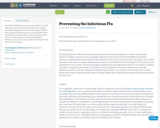
This PBL is designed for second grade students. To help understand our school and how to keep the students and staff healthy, the students will investigate different ways to prevent influenza germs from spreading. After considering each germ, they will have the opportunity to create evidence by researching and talking to different resources to come up with the best prevention method for our school.
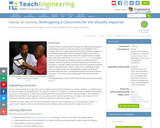
Students practice human-centered design by imagining, designing and prototyping a product to improve classroom accessibility for the visually impaired. To begin, they wear low-vision simulation goggles (or blindfolds) and walk with canes to navigate through a classroom in order to experience what it feels like to be visually impaired. Student teams follow the steps of the engineering design process to formulate their ideas, draw them by hand and using free, online Tinkercad software, and then 3D-print (or construct with foam core board and hot glue) a 1:20-scale model of the classroom that includes the product idea and selected furniture items. Teams use a morphological chart and an evaluation matrix to quantitatively compare and evaluate possible design solutions, narrowing their ideas into one final solution to pursue. To conclude, teams make posters that summarize their projects.

Presently, over five trillion pieces of plastic litter the ocean. Not only is it damaging the marine life, but can also cause serious problems for humans. The Ocean Cleanup removes plastic from bodies of water since 2014. First, they focused on the Great Pacific Garbage Patch, but research showed that the most plastic in oceans comes from rivers. They built interceptors to collect plastic waste from rivers in Malaysia, Indonesia, Dominican Republic and Vietnam. The goal is to remove plastic from 1000 rivers in five years. If their technology works properly for a long time, then by 2040 90% of plastic waste could be removed in all oceans.
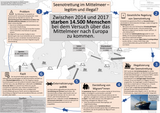
Die Rettung schiffbrüchiger Migrant*innen auf dem Mittelmeer hat in den vergangenen Jahren eine politische Debatte ausgelöst, die die EU vor einen inneren Konflikt stellt. Der Konflikt zwischen Verpflichtung der Menschenrechte und Sicherheitspolitik hat zu einer Politik der Illegalisierung von Seenotrettung geführt. Diese wird durch die Darstellung von Migrant*innen als Gefahr für Europa gerechtfertigt, und durch die Externalisierungspolitik der EU verstärkt. Letztendlich kann die Illegalisierung der Seenotrettung als politisch motiviert eingestuft werden und führt dazu, dass das Mittelmeer zurzeit die tödlichste Grenze der Welt ist.

Die Überfischung der Ozeane ist eine globale Herausforderung. Weltweit gelten 29 Prozent aller Fischbestände als überfischt. Welche Ursachen hat die Überfischung und welche Maßnahmen werden ergriffen, um diese einzudämmen und den Fischbestand nachhaltig zu sichern? Mit dem Nordseehering wird dabei ein Beispiel für erfolgreich betriebenes Fischereimanagement aufgezeigt, da die Art sich nach einem Zusammenbrechen des Bestands inzwischen erholt hat.

In synergy with SDG 15, target 15.3, to strive to achieve a land degradation-neutral world by 2030, the UNCCD has initiated an LDN target setting programme, which 127 nations so far committed to. As one of these nations, South Africa’s government has developed national and sub-national targets to face the pressing threat of land degradation. With a land surface made of 91% dryland the country is especially prone to desertification, degradation and drought, while their population is highly dependant on agricultural activities to obtain food security. The Sustainable Land Management Programme intends to secure multiple ecosystem benefits in 3 pilot sites to implement nationwide policies.
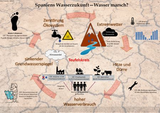
Wasser sparen in Europa? Im Zuge des Klimawandels müssen sich auch die europäischen BewohnerInnen Gedanken um die zukünftige Wasserversorgung machen. Im Süden Spaniens, geprägt von einem mediterranen Klima fließen 68,2% des Wasserverbrauchs in die Landwirtschaft. Problematisch ist der hohe Export von virtuellem Wasser, was dem Land und den BewohnerInnen auf Dauer in die Wasserkrise führt. Spanien befindet sich bereits heute in einem Teufelskreis, welcher sich immer schneller zu bewegen beginnt.
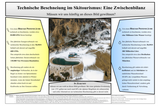
Die Antwort des alpinen Skitourismuses auf den Klimawandel ist klar und sie lautet: Technische Beschneiung. In Zahlen bedeutet dies, dass sich die beschneibare Pistenfläche beispielsweise in der Schweiz verdoppelt und in Bayern fast verdreifacht hat (Hahn, 2004). Dieser massive Infrastrukturausbau ist damit zu erklären, dass bei einer Erwärmung des Klimas um +2°C nur noch etwa 60% der Skigebiete in den Alpen als schneesicher gelten und damit auf technische Maßnahmen angewiesen sind. Was hat das wiederum für Folgen für die Umwelt? Wie hoch ist der Wasser- und Energiebedarf von technischer Beschneiung? Ist der Skitourismus letztendlich Klimawandeltreiber oder doch nur Klimawandelverlierer?
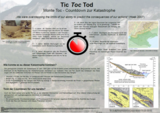
Tic Toc Tod - Countdown zur Katastrophe
1963 ereignete sich eine gravierende menschengemachte Naturkatastrophe. Etwa 270 Million m³ Gestein des Monte Toc, nahe Venedig, stürzten am 09. Oktober 1963 in den am Fuße des Berges angelegten Vajont-Stausee. Die dadurch entstandene Flutwelle überwand die errichtete Staumauer und zerstörte unter anderem des Städtchen Longarone. Bei diesem Unglück starb etwa 2000 Menschen. Noch bis heute beschäftigen Experten sich mit folgenden Fragestellungen:
„Wie kam es zu diesem Unglück?“ (geologische und menschliche Ursachen),
„Wie hätte dieses Unglück verhindert werden können?“ und
„Könnte sich diese Naturkatastrophe auch in den Alpen wiederholen?“
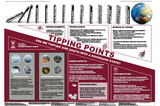
Tipping points are critical points at which sub-systems of our planet are drastically altered by small disruptions. Tipping a system leads to irreversible responses which can push the Earth into a Hothouse state. Past the tipping point, self-reinforcing feedbacks within the system instead of human influences will become the main drivers of change. Additionally, so-called domino effects will amplify changes as tipping of one system leads to tipping of others. Although it might be too late for some systems, it is imperative that the Paris Climate Agreement goals are reached in order to prevent the drastic and unforeseeable changes that result from tipping our Earth’s systems.
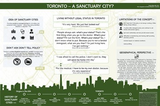
Living in Toronto without legal status goes along with many disadvantages and problems in daily life. Local initiatives have been fighting against these circumstances since the 1980s. 2004, a Don’t Ask Don’t Tell-Policy was implemented. In 2013, Toronto’s status as a Sanctuary City was legally codified. The poster explains the historical formation of Sanctuary Cities, details relevant policies and barriers to implementation in the city of Toronto.
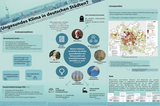
Auch in Deutschland betrifft der Klimawandel nicht alle Menschen und deren Gesundheit gleichermaßen. Soziale Ungleichheiten verstärken intersektional die Auswirkungen von Klimawandel und Umweltbelastungen auf die Gesundheit. Mit den Ansätzen der Environmental Justice und Feminist Political Ecology soll auf intersektionale Merkmale der Umwelt(un)gerechtigkeit im Bezug auf Gesundheit geschaut werden und auch Lösungsstrategien für mehr Umweltgerechtigkeit, unter anderem am Beispiel Berlins, vorgestellt werden.

Das Jordanbecken ist seit fast einem Jahrhundert Schauplatz diverser Konflikte, bei dem die Ressource Wasser im Mittelpunkt steht. Der Jordan stellt in dieser trockenen Region eine wichtige Wasserversorgung dar, doch der Zugang und die Aufteilung sind ungleich aufgeteilt. Durch die zahlreichen, blutigen Auseinandersetzungen erlangte Israel die größte hydrostrategische Macht, was sich bis heute kaum verändert hat. Vor allem Jordanien und die palästinensische Bevölkerung leiden darunter, da diese beiden Länder wenig weitere Wasserquellen nutzen können. Eine allumfassende diplomatische Konfliktlösung der Wassermangelproblematik ist bis heute nicht gefunden worden.

Water is more than just a natural resource. Its materialities and discourses are intrinsically intertwined with continually changing social processes. In a world that is increasingly influenced by anthropogenic actions, this hybrid character leads to conflicts over and because of water. This poster analyzes the connections and interdependencies between water and society. For this, the social character of water as well as central approaches of Political ecology are shown and ultimately connected to the phenomenon of water conflicts. It is then presented what drivers lead to water conflicts, how they can be classified and which alternative solutions of governing water emerge from conflicts.
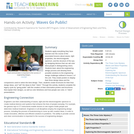
Students apply everything they have learned over the course of the associated lessons about waves, light properties, the electromagnetic spectrum, and the structure of the eye, by designing devices that can aid color blind people in distinguishing colors. Students learn about the engineering design process and develop three possible solutions to the engineering design challenge outlined in lesson 1 of this unit. They create posters to display their three design ideas and the comparisons used to select the best design. Then, students create brochures for their final design ideas, and "sell" the ideas to their "client." Through this activity, students complete the legacy cycle by "going public" with the creation of their informative posters and brochures that explain their designs, as well as color blindness and how people see color, in "client" presentations.
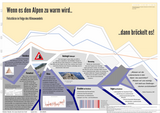
Felsstürze sind in den Alpen keine Seltenheit. Allerdings haben sie in den letzten Jahren stark zugenommen. Dies lässt sich durch klimawandelbedingte Erwärmung in den Alpen erklären. Dadurch erwärmt sich der Permafrost oder taut ganz auf, welcher das Gestein stabilisiert. Die Hänge werden instabil und stürzen ab. Welche Konsequenzen hat das für uns Menschen? Welche Methode(n) der Überwachung und Vorhersage gibt es?

Die phänologische Uhr stellt den Verlauf der Jahreszeiten anhand von periodisch wiederkehrenden Naturerscheinungen der Pflanzenwelt dar (z.B. Blütenaufbruch, Fruchtreife, Blattfall). Die Unterteilung in zehn Jahreszeiten erfolgt anhand von Leitphasen, die für bestimmte Regionen definiert sind. Im Zeitverlauf konnten in Mitteleuropa Veränderungen der phänologischen Phasen beobachtet werden, welchen verschiedene Einflussfaktoren zugrunde liegen. Die Veränderungen betreffen jedoch nicht nur die Pflanzenwelt. Aufgrund von komplexen intra- und interspezifischen Zusammenhängen, haben phänologische Veränderungen einer Art oft weitreichende Auswirkungen auf andere Arten und ganze Ökosysteme.

Die Plastikverschmutzung in den Ozeanen ist inzwischen zu einem großen Problem auf dem Planeten geworden. Dabei kommt Plastik in verschiedenen Arten im Wasser vor und lässt sich auf jedem Fleck der Erde im Wasser ausfindig machen. In den letzten Jahren sind einige Projekte entstanden, die sich als Ziel gesetzt haben Plastik aus den Ozeanen zu entfernen (Plastic Removal).
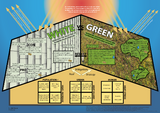
Urbanization is a world wide phenomenon. Vegetated areas get replaced by dark coloured buildings and increase the heat storage capacity dramatically. Additionally, the human body is vulnerable to heat events which will occur more regularly in the future because of climate change. There are many mitigation strategies that try to adapt the existing infrastructure to the possible natural hazards. One option would be to increase the reflection of solar radiation on surfaces. But is this the most effective way to reduce heat in cities? Or could green roofs have a greater cooling effect on buildings?